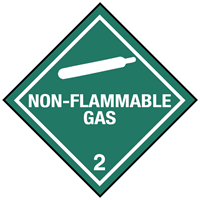
 Print
Print
Chemical Datasheet
NITROGEN, REFRIGERATED LIQUID (CRYOGENIC LIQUID) |

|
Chemical Identifiers
| CAS Number |
UN/NA Number |
DOT Hazard Label |
USCG CHRIS Code |
|
|
|
|
|
| NIOSH Pocket Guide |
International Chem Safety Card |
|
none
|
- NITROGEN (COMPRESSED GAS)
- NITROGEN (LIQUIFIED)
|
NFPA 704
General Description
Colorless odorless liquid. Very cold. Contact may cause frostbite. Nontoxic. Under prolonged exposure to heat or fire the container may rupture violently and rocket. Used to freeze foods, to preserve whole blood and other biologicals, and as a coolant.
Hazards
Reactivity Alerts
none
Air & Water Reactions
No rapid reaction with air. No rapid reaction with water.
Fire Hazard
Behavior in Fire: Containers may explode when heated. (USCG, 1999)
Health Hazard
Inhalation can cause asphyxiation, if atmosphere does not contain oxygen; dizziness, unconsciousness, or even death can result. Contact of liquid with skin or eyes causes frostbite burns. (USCG, 1999)
Reactivity Profile
NITROGEN, REFRIGERATED LIQUID (CRYOGENIC LIQUID) is very unreactive. Nonflammable, noncombustible and nontoxic. Vapors can fill closed spaces and asphyxiate. Contact with water may result in vigorous or violent boiling and extremely rapid vaporization. If the water is hot, there is the possibility that a liquid "superheat" explosion may occur. Pressures may build to dangerous levels if the liquid contacts water in a closed container [Handling Chemicals Safely 1980].
Belongs to the Following Reactive Group(s)
Potentially Incompatible Absorbents
No information available.
Response Recommendations
Isolation and Evacuation
Excerpt from ERG Guide 120 [Gases - Inert (Including Refrigerated Liquids)]:
IMMEDIATE PRECAUTIONARY MEASURE: Isolate spill or leak area for at least 100 meters (330 feet) in all directions.
LARGE SPILL: Consider initial downwind evacuation for at least 100 meters (330 feet).
FIRE: If tank, rail tank car or highway tank is involved in a fire, ISOLATE for 800 meters (1/2 mile) in all directions; also, consider initial evacuation for 800 meters (1/2 mile) in all directions. (ERG, 2024)
Firefighting
Excerpt from ERG Guide 120 [Gases - Inert (Including Refrigerated Liquids)]:
Use extinguishing agent suitable for type of surrounding fire. If it can be done safely, move undamaged containers away from the area around the fire. Damaged cylinders should be handled only by specialists.
FIRE INVOLVING TANKS: Fight fire from maximum distance or use unmanned master stream devices or monitor nozzles. Cool containers with flooding quantities of water until well after fire is out. Do not direct water at source of leak or safety devices; icing may occur. Withdraw immediately in case of rising sound from venting safety devices or discoloration of tank. ALWAYS stay away from tanks in direct contact with flames. (ERG, 2024)
Non-Fire Response
Excerpt from ERG Guide 120 [Gases - Inert (Including Refrigerated Liquids)]:
Do not touch or walk through spilled material. Stop leak if you can do it without risk. Use water spray to reduce vapors or divert vapor cloud drift. Avoid allowing water runoff to contact spilled material. Do not direct water at spill or source of leak. If possible, turn leaking containers so that gas escapes rather than liquid. Prevent entry into waterways, sewers, basements or confined areas. Allow substance to evaporate. Ventilate the area. CAUTION: When in contact with refrigerated/cryogenic liquids, many materials become brittle and are likely to break without warning. (ERG, 2024)
Protective Clothing
Safety glasses or face shield; insulated gloves; long sleeves; trousers worn outside boots or over high-top shoes to shed spilled liquid; self-contained breathing apparatus where insufficient air is present. (USCG, 1999)
DuPont Tychem® Suit Fabrics
No information available.
First Aid
INHALATION: remove to fresh air; apply artificial respiration if breathing has stopped; call physician.
EYES: treat for frostbite burns caused by liquid.
SKIN: treat for frostbite; soak in lukewarm water. (USCG, 1999)
Physical Properties
Flash Point: data unavailable
Lower Explosive Limit (LEL): data unavailable
Upper Explosive Limit (UEL): data unavailable
Autoignition Temperature: data unavailable
Melting Point:
-354°F
(USCG, 1999)
Vapor Pressure: data unavailable
Vapor Density (Relative to Air): data unavailable
Specific Gravity:
0.807
at -319.9°F
(USCG, 1999)
- Less dense than water; will float
Boiling Point:
-320.1°F
at 760 mmHg
(USCG, 1999)
Molecular Weight:
28
(USCG, 1999)
Water Solubility: data unavailable
Ionization Energy/Potential: data unavailable
IDLH: data unavailable
AEGLs (Acute Exposure Guideline Levels)
No AEGL information available.
ERPGs (Emergency Response Planning Guidelines)
No ERPG information available.
PACs (Protective Action Criteria)
| Chemical |
PAC-1 |
PAC-2 |
PAC-3 |
| Nitrogen (7727-37-9)
|
796000 ppm |
832000 ppm |
869000 ppm |
(DOE, 2024)
Regulatory Information
EPA Consolidated List of Lists
No regulatory information available.
CISA Chemical Facility Anti-Terrorism Standards (CFATS)
No regulatory information available.
OSHA Process Safety Management (PSM) Standard List
No regulatory information available.
Alternate Chemical Names
- LIQUID NITROGEN
- NITROGEN
- NITROGEN (LIQUEFIED)
- NITROGEN, REFRIGERATED LIQUID (CRYOGENIC LIQUID)
- NITROGEN, [REFRIGERATED LIQUID]


 Print
Print
